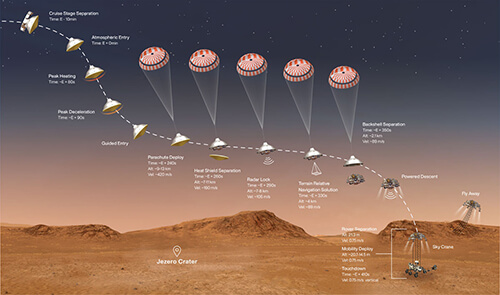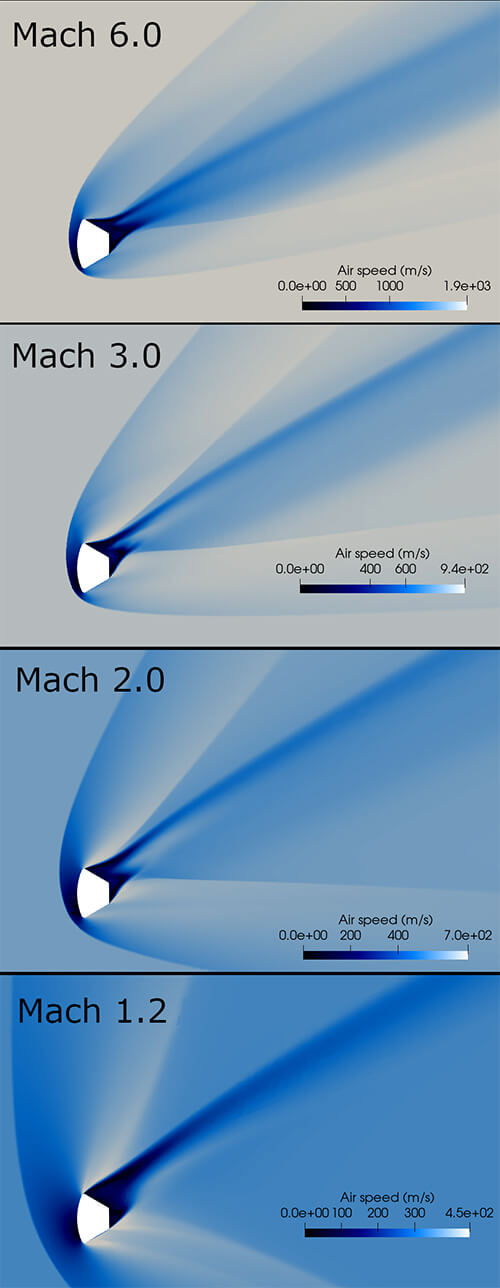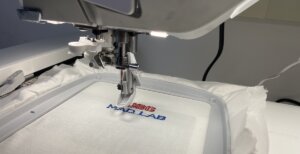
Artistic rendering of NASA’s Orion capsule re-entering Earth’s atmosphere (Image credit: NASA)
Destination: Mars. It’s a worthy goal, but what’s really required when the “rubber meets the road”? Or, more literally, when a spacecraft enters a planetary atmosphere and prepares to land safely – a process affectionately known as the “7 minutes of terror.”
Why so notorious? Whether landing on Earth, Mars or Titan (one of the moons of Saturn), the stage of a space mission known as entry, descent and landing (EDL) involves a process of deacceleration that can be tricky to fine-tune.
“Entry of a spacecraft into an atmosphere before landing typically happens at hypersonic speeds, often exceeding 20 times the speed of sound,” explains Ivan Bermejo-Moreno, assistant professor of Aerospace and Mechanical Engineering. “To slow down the spacecraft, that energy needs to be dissipated in the few minutes before landing, which makes the process very risky. Heat is produced near the space vehicle by viscous friction of the gas in the atmosphere, and we have to find a way to absorb and dissipate that heat without compromising the vehicle as it descends. That’s a key problem I’m trying to solve in my research.”
The way heat is transferred to the vehicle is vital for ensuring the safe passage of the cargo or passengers. It’s not unusual for spacecrafts to burn up as they enter the atmosphere of Mars – in fact, only around 50% of missions to the red planet have achieved successful EDL. It’s enough to make even the most seasoned space-tourist feel queasy.

The different phases of EDL for NASA’s mission to land the Perseverance rover on Mars (Image credit: NASA/Caltech-JPL)
The perils of EDL are also a key concern for NASA as it pursues the ambitious Artemis program. This year, they called on early career faculty to propose research projects focused on fluid mechanics during the EDL phase, and Bermejo-Moreno has been awarded a three-year NASA Early Career Faculty Award to pursue his computational studies of hypersonic flight.
Flow simulation in high fidelity
Bermejo-Moreno’s Computational Aerospace Lab investigates the ways in which turbulent fluid flows interact with physical phenomena such as shock waves, combustion and solid structures, applying numerical simulation and diagnostic tools for greater accuracy of prediction.
The new project for NASA involves developing more accurate models to predict the transition from smooth laminar flow to chaotic turbulent flow during EDL. “It’s critically important to predict where the flow becomes turbulent, because that dictates how much heat transfer needs to be supported by the vehicle,” explained Bermejo-Moreno. “Those predictions will inform how the thermal protection system of the vehicle is designed, which determines the type and thickness – or ‘dimension’ – of the material that covers the vehicle and the geometry of your vehicle as it descends.”
Uncertainty in the prediction of the amount of heat transferred to the vehicle has traditionally prompted engineers to over-dimension the thermal protection system for the sake of increasing the safety margin during EDL. So far, that protocol has improved success rates. But here’s the catch. An over-dimensioned thermal protection system accounts for a large fraction of the weight of the vehicle, thereby limiting the size and payload of the vehicles that can enter the super-thin atmosphere of Mars.
“That’s where we come in,” said Bermejo-Moreno. “With better accuracy in the prediction of heat transferred to the vehicle, it may be possible to decrease the thickness of a vehicle’s thermal protection system for greater efficiency of design.”
To achieve this ambitious new phase of space exploration will require a new approach to the way flow is simulated – making the leap from previously acceptable low-fidelity models, to high-fidelity models that provide better predictive capability.
“Imagine capturing a high-resolution photo which gives you access to a lot of visual information,” said Bermejo-Moreno. “Now, imagine you have a cheaper camera that allows you to quickly take many more pictures, but those images are more pixelated and inaccurate. That’s essentially the difference between high and low-fidelity simulations for predicting the transition from laminar to turbulent flow. Although high-fidelity methods might be more computationally expensive, they give you much more information and accuracy – comparable to what you would gain from an experiment.”
The new race for high-speed flight
There’s a trade-off to be made in computation costs, but the investment is worth it for the ripple effects.

Visualization of the air flow around the Orion space capsule at different flight speeds (Mach numbers) during reentry into Earth’s atmosphere. Results obtained from numerical simulations conducted in Bermejo-Moreno’s research group within NASA’s Aerofusion project.
Back here on Earth, we’re witnessing renewed interest in high-speed flight. While the supersonic airliner, Concorde, might not have been financially sustainable, new developments in space technology can change what is possible within our own atmosphere.
“This particular research project focuses on entry, descent and landing for space missions, but the ramifications can expand into any type of high-speed flight,” said Bermejo-Moreno. “On the one hand, there’s the potential of sustainable supersonic flight for more efficient global travel. And then there’s the question of hypersonic flight for military applications – such as weapons and missile development – and further civil and commercial applications.”
The possibilities are expansive – and so are the challenges. Every time the Mach number is raised (the ratio of flight speed to the local speed of sound), you’re faced with new physical phenomena. That’s why accurate predictive models are so important for designing efficient flow surfaces, and why Bermejo-Moreno’s high-fidelity models have the potential to change how we fly in the future.
“It’s a remarkable time to be working in the field of aerospace and astronautics,” said Bermejo-Moreno. “Back in the 20th century we experienced the space race to land on the moon. Now, we’re in a race to develop feasible hypersonic and supersonic flight. At the same time, there’s the artificial intelligence race – which is changing how we conduct research and the type of technological advancement we can achieve. There’s no way of entirely predicting what comes next – but we can create ever better models.”
Published on November 3rd, 2023
Last updated on December 9th, 2024













